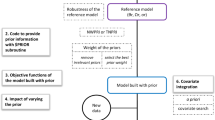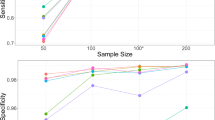Abstract
The ultimate goal in drug development is to establish the manner of safe and efficacious administration to patients. To achieve this in an efficient way the information contained in the clinical studies should contribute to the increasing pool of accumulated knowledge. The aim of this simulation study is to investigate different knowledge-propagation strategies when the data is analysed using a model-based approach in NONMEM. Pharmacokinetic studies were simulated according to several scenarios of the underlying model and study design, including a population-optimal design based on analysis of a previous study. Five approaches with different degrees of knowledge propagation were investigated: analysing the studies pooled into one dataset, merging the results from analysing the studies separately, fitting a pre-specified model that has been selected from a previous study on either the most recent study or on the pooled dataset, or naïvely analysing the most recent study without any regards to any previous study. The approaches were evaluated on what model was selected (qualitative knowledge, investigated by stepwise covariate selection within NONMEM) as well as parameter precision (quantitative knowledge) and predictive performance of the model. Pooling all studies into one dataset is the best approach for identifying the correct model and obtaining good predictive performance and merging the results of separate analyses may perform almost as well. Fitting a pre-specified model on new data is fast, without selection bias, and sanctioned for model-based confirmatory analyses. However, fitting the same pre-specified model to all available data is still fast and can be expected to perform better in terms of predictive performance than the unbiased alternative. Using ED-optimal design of sample times and stratification of subjects from different subgroups is a successful strategy which allows sparse sampling and handles prior parameter uncertainty.
Similar content being viewed by others
References
Laporte-Simitsidis S, Girard P, Mismetti P, Chabaud S, Decousus H and Boissel JP (2000). Inter-study variability in population pharmacokinetic meta-analysis: when and how to estimate it?. J Pharm Sci 89(2): 155–167
Sheiner LB (1997). Learning versus confirming in clinical drug development. Clin Pharmacol Ther 61(3): 275–291
Sheiner LB and Steimer JL (2000). Pharmacokinetic/pharmacodynamic modeling in drug development. Annu Rev Pharmacol Toxicol 40: 67–95
Jonsson EN and Sheiner LB (2002). More efficient clinical trials through use of scientific model-based statistical tests. Clin Pharmacol Ther 72(6): 603–614
Bhattaram VA, Booth BP, Ramchandani RP, Beasley BN, Wang YN and Tandon V (2005). Impact of pharmacometrics on drug approval and labeling decisions: a survey of 42 new drug applications. AAPS J 7(3): E503–E512
Marshall S, Macintyre F, James I, Krams M and Jonsson NE (2006). Role of mechanistically-based pharmacokinetic/pharmacodynamic models in drug development—A case study of a therapeutic protein. Clin Pharmacokinet 45(2): 177–197
Zhang L, Sinha V, Forgue ST, Callies S, Ni L and Peck R (2006). Model-based drug development: the road to quantitative pharmacology. J Pharmacokinet Pharmacodyn 33(3): 369–393
Beal SL, Sheiner LB (1994) NONMEM Users Guides. NONMEM Project Group, University of California at San Francisco, San Francisco
Zingmark PH, Ekblom M, Odergren T, Ashwood T, Lyden P and Karlsson MO (2003). Population pharmacokinetics of clomethiazole and its effect on the natural course of sedation in acute stroke patients. Br J Clin Pharmacol 56(2): 173–183
Ribbing J and Jonsson EN (2004). Power, selection bias and predictive performance of the population pharmacokinetic covariate model. J Pharmacokinet Pharmacodyn 31(2): 109–134
Foracchia M, Hooker A, Vicini P and Ruggeri A (2004). POPED, a software for optimal experiment design in population kinetics. Comput Methods Programs Biomed 74(1): 29–46
FDA (2006) Drug interaction studies—study design, data analysis, and implications for dosing and labeling (http://www.fda.gov/cber/gdlns/interactstud.htm)
Wade JR, Edholm M and Salmonson T (2005). A guide for reporting the results of population pharmacokinetic analyses: a Swedish perspective. AAPS J 7(2): 45
Zhou H (2006). Population-based assessments of clinical drug–drug interactions: qualitative indices or quantitative measures?. J Clin Pharmacol 46(11): 1268–1289
MATLAB. In Version 7.0.1.24704 (R14) Service Pack 1 ed. Natick, MA, United States: MathWorks
Jonsson EN and Karlsson MO (1998). Automated covariate model building within NONMEM. Pharm Res 15(9): 1463–1468
Wahlby U, Jonsson EN and Karlsson MO (2001). Assessment of actual significance levels for covariate effects in NONMEM. J Pharmacokinet Pharmacodyn 28(3): 231–252
Lindbom L, Pihlgren P and Jonsson EN (2005). PsN-Toolkit–a collection of computer intensive statistical methods for non-linear mixed effect modeling using NONMEM. Comput Methods Programs Biomed 79(3): 241–257
Lindbom L, Ribbing J and Jonsson EN (2004). Perl-speaks-NONMEM (PsN)–a Perl module for NONMEM related programming. Comput Methods Programs Biomed 75(2): 85–94
Raab GM, Day S and Sales J (2000). How to select covariates to include in the analysis of a clinical trial. Control Clin Trials 21(4): 330–342
Harrell FE (2001) 4.1 Prespecification of predictor complexity without later simplification. In: Regression modeling strategies. Springer-Verlag, New York, pp. 53–56
Kerbusch T, Wahlby U, Milligan PA and Karlsson MO (2003). Population pharmacokinetic modelling of darifenacin and its hydroxylated metabolite using pooled data, incorporating saturable first-pass metabolism, CYP2D6 genotype and formulation-dependent bioavailability. Br J Clin Pharmacol 56(6): 639–652
Hedges LV (1992). Meta-analysis. J Educ Stat 17(4, Special Issue: Meta Analysis): 279–296
Mosteller F and Colditz GA (1996). Understanding research synthesis (meta-analysis). Annu Rev Public Health 17: 1–23
Bruno R, Vivler N, Vergniol JC, De Phillips SL, Montay G and Sheiner LB (1996). A population pharmacokinetic model for docetaxel (Taxotere): model building and validation. J Pharmacokinet Biopharm 24(2): 153–172
Sheiner LB and Beal SL (1981). Some suggestions for measuring predictive performance. J Pharmacokinet Biopharm 9(4): 503–512
Van Houwelingen JC and le Cessie S (1990). Predictive value of statistical-models. Stat Med 9(11): 1303–1325
Waterhouse TH, Redmann S, Duffull SB and Eccleston JA (2005). Optimal design for model discrimination and parameter estimation for itraconazole population pharmacokinetics in cystic fibrosis patients. J Pharmacokinet Pharmacodyn 32(3–4): 521–545
Altman DG and Andersen PK (1989). Bootstrap investigation of the stability of a Cox regression model. Stat Med 8(7): 771–783
Wakefield J (2000). The combination of population pharmacokinetic studies. Biometrics 56(1): 263–270
Wakefield J and Bennett J (1996). The Bayesian modeling of covariates for population pharmacokinetic models. J Am Stat Assoc 91(435): 917–927
Jonsson F, Jonsson EN, Bois FY and Marshall S (2007). The application of a Bayesian approach to the analysis of a complex, mechanistically based model. J Biopharm Stat 17(1): 65–92
Hoijtink H and Klugkist I (2007). Comparison of hypothesis testing and Bayesian model selection. Qual Quant 41(1): 73–91
Gisleskog PO, Karlsson MO and Beal SL (2002). Use of prior information to stabilize a population data analysis. J Pharmacokinet Pharmacodyn 29(5–6): 473–505
5.7 Subgroups (1998) Interactions and Covariates. In: Products TEAftEoM (ed) Statistical principles for clinical trials. London, pp 28–29
Steyerberg EW, Eijkemans MJC, Harrell FE and Habbema JDF (2000). Prognostic modelling with logistic regression analysis: a comparison of selection and estimation methods in small data sets. Stat Med 19(8): 1059–1079
Bonate PL (1999). The effect of collinearity on parameter estimates in nonlinear mixed effect models. Pharm Res 16(5): 709–717
Steyerberg EW, Eijkemans MJC, Lee KL, Habbema JDF and Houwelingen JC (2000). Prognostic models based on literature and individual patient data in logistic regression analysis. Stat Med 19(2): 141–160
Jonsson EN, Wade JR and Karlsson MO (1996). Comparison of some practical sampling strategies for population pharmacokinetic studies. J Pharmacokinet Biopharm 24(2): 245–263
Author information
Authors and Affiliations
Corresponding author
Rights and permissions
About this article
Cite this article
Ribbing, J., Hooker, A.C. & Jonsson, E.N. Non-Bayesian knowledge propagation using model-based analysis of data from multiple clinical studies. J Pharmacokinet Pharmacodyn 35, 117–137 (2008). https://doi.org/10.1007/s10928-007-9079-8
Received:
Accepted:
Published:
Issue Date:
DOI: https://doi.org/10.1007/s10928-007-9079-8




